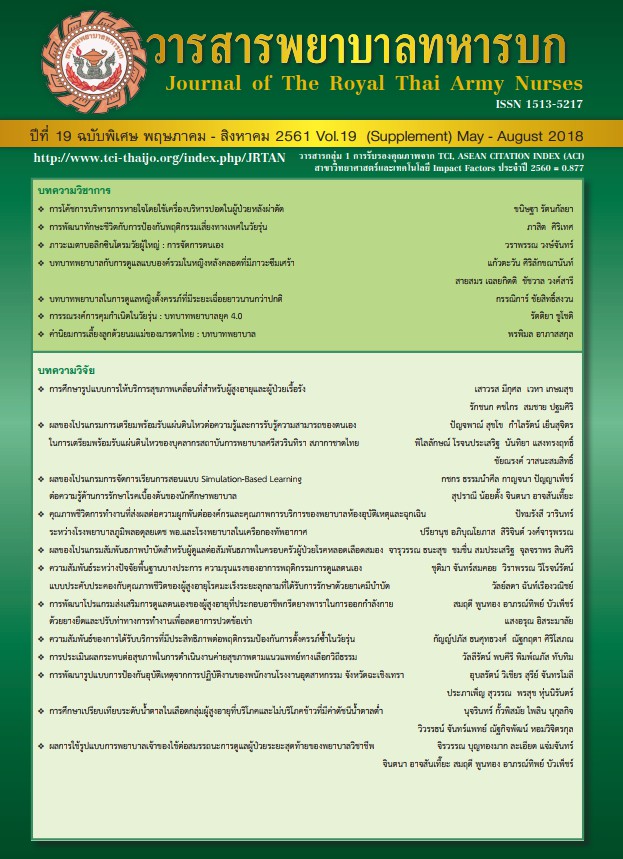The Factors Predicting The Mobility of Stroke Patients During The First Year of Stroke
Keywords:
Factor predicting of the mobility, Mobility, Stroke during the first yearAbstract
This predictive research was to determine the factors predicting mobility after stroke during the first year. The sample were the stroke patients who following at the hospitals in the Ministry of Public Health Region 4. The total samples were conducted by proportional random, 210 participants, who met the eligible criteria. The research instruments composed of 1) Demographic Data and Health Status Questionnaire 2) Mobility Self-Efficacy Scale 3) Perceived Susceptibility Scale and 4) Activity of Daily Living and Mobility Assessment. Data were analyzed using Descriptive statistics, Chi-square test, Pearson’s product correlation coefficient, Spearman’s Rank correlation coefficient, and Stepwise multiple regression analysis. The results found that the mean scores of participant’s mobility were high level. By examining the Stepwise multiple regression for prediction, it was found that the factors could predict mobility self-efficacy, muscle power, mobility complications, body mass index, and perceived susceptibility of decrease mobility (p < .05). All five variables were able to predict mobility at 58.8%. The findings of study supported ICF model of WHO that the health status factors and the modifying factors were correlated and could predict mobility of the stroke patients during the first year. These data can be useful for health promotion of mobility after stroke for increasing quality of life later.
Downloads
References
Strategic and Planning Division Office of the Permanent Secretary, Ministry of Public Health. Public health statistic 2016. Nonthaburi: Ministry of Public Health; 2017. (In Thai)
Warlow, C. P., Al-Shahi, R., Bhattacharya, J. J., Currie, D. G., Papanastassiou, V., Ritchie, V.,.Roberts, R. C., Prospective, population-based detection of intracranial vascular malformations in adults the Scottish intracranial vascular malformation study (SIVMS). Stroke. 2003; 34(5):1163-1169.
World Health Organization. International classification of functioning, disability and health ICF. Geneva: World Health Organization; 2001.
Khomkham, K., Rattanathanya, D., & Krainuwat, K. Predictive factors for adaptation among caregivers of stroke patients. Journal of The Royal Thai Army Nurses. 2015;16(2):114-122. (In Thai)
Ingrid, G. L., Port, M., Kwakkel, G., Vera, P. M., & Lindeman, E. Predicting mobility outcome one year after stroke. Rehab Med. 2006;38:218-223.
Bandura, A. Self-efficacy toward a unifying theory of behavioral change. Psychological Review. 1977;84(2): 191-215.
Tieges, Z., Mead, G., Allerhand, M., Duncan, F., van Wijck, F., Fitzsimons, C.,.& Chastin, S. Sedentary behavior in the first year after stroke: a longitudinal cohort study with objective measures. Archives of Physical Medicine and Rehabilitation. 2015;96(1):15-23.
Becker, M.H. The health belief model and personal health behavior. Health Education Monographs. 1974;2:324- 508.
Jones, F., Partridge, C., & Reid, F. The stroke self-efficacy questionnaire: measuring individual confidence in functional performance after stroke. Journal of Clinical Nursing. 2008;17(7) :244-252.
Corrie, K., Japp, van der, B., & Thora, H. Self-efficacy and its influence on recovery of patients with stroke: a systematic review. Journal of Advance Nursing. 2011;67(9):1876-1894.
Hellstrom, K., Lindmark, B., Wahlberg, B., & Fugl-Meyer, A. R. Self-efficacy in relation to impairments and activities of daily living disability in elderly patients with stroke a prospective investigation. Journal of Rehabilitation Medicine. 2003;35(5):202-207.
Mahunkhanukhro, P. Locomotive system. Chiangmai: Chaingmai University; 2015. (In Thai)
Kyoung, B. L., Seong, H. L., Eun, H. K., Yong, S. K., Kang, S. L., & Byong, Y. H. Factor related to community ambulation in patients with chronic stroke. Journal Topics in Stroke Rehabilitation. 2015;22(1):63-71.
Civelek, G. M., Atalay, A., & Turhan, N. Medical complication experienced by first-time ischemic stroke patients during inpatient, tertiary level stroke rehabilitation. The Journal of Physical Therapy Science. 2016;28:382-391.
Leoned, K., Deborah, A., IIuly, T. The impact of patient ’s weight on post stroke rehabilitation. Disability and Rehabilitation. 2016;38(17), 1684-1690.
Downloads
Published
How to Cite
Issue
Section
License
บทความหรือข้อคิดเห็นใดใดที่ปรากฏในวารสารพยาบาลทหารบกเป็นวรรณกรรมของผู้เขียน ซึ่งบรรณาธิการหรือสมาคมพยาบาลทหารบก ไม่จำเป็นต้องเห็นด้วย
บทความที่ได้รับการตีพิมพ์เป็นลิขสิทธิ์ของวารสารพยาบาลทหารบก
The ideas and opinions expressed in the Journal of The Royal Thai Army Nurses are those of the authors and not necessarily those
of the editor or Royal Thai Army Nurses Association.






